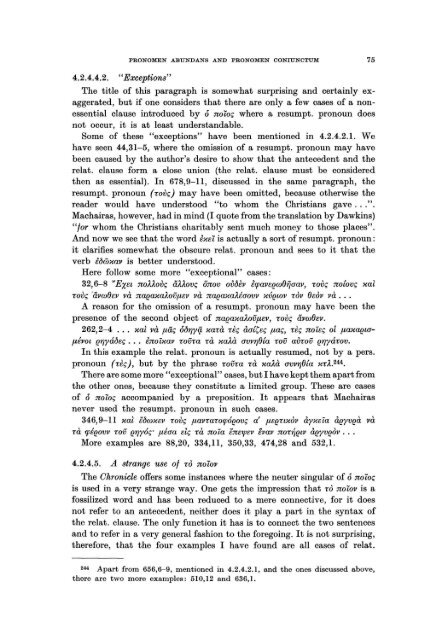Pronomen Abundans and Pronomen Coniunctum. A ... - DWC
Pronomen Abundans and Pronomen Coniunctum. A ... - DWC
Pronomen Abundans and Pronomen Coniunctum. A ... - DWC
Create successful ePaper yourself
Turn your PDF publications into a flip-book with our unique Google optimized e-Paper software.
PRONOMEN ABUNDANS AND PRONOMEN CONIUNCTUM 75<br />
4.2.4.4.2. "Exceptions"<br />
The title of this paragraph is somewhat surpnsmg <strong>and</strong> certainly exaggerated,<br />
but if one considers that there are only a few cases of a nonessen<br />
ti al clause introduced by ó notoç where a resumpt. pronoun does<br />
not occur, it is at least underst<strong>and</strong>able.<br />
Some of these "exceptions" have been mentioned in 4.2.4.2.l. We<br />
have se en 44,31-5, where the omission of a resumpt. pronoun may have<br />
been caused by the author's desire to show that the antecedent <strong>and</strong> the<br />
relat. cl au se form a close union (the relat. clause must be considered<br />
then as essential). In 678,9-11, discussed in the same paragraph, the<br />
resumpt. pronoun (r:ovç) may have been omitted, because otherwise the<br />
reader would have understood "to whom the Christians gave ... ".<br />
Machairas, however, had in mind (I quote from the translation by Dawkins)<br />
"tor whom the Christians charitably sent much money to those places".<br />
And now we see that the word è'Xû is actually a sort of resumpt. pronoun:<br />
it clarifies somewhat the obscure relat. pronoun <strong>and</strong> sees to it that the<br />
verb Èów'Xav is better understood.<br />
Here follow some more "exceptional" cases:<br />
32,6-8 )fEXët noÀÀovç a,1,Äovç önov ovbèv èq;aveewOijaav, 7:0Vç nolovç "al<br />
r:ovç ëlvwfJsv và Jweu'XuÀOVftSV và JWeu'XuÀürovv 'Xvewv r:àv fJsàv và ...<br />
A reason for the omission of a resumpt. pronoun may have been the<br />
presence of the second object of nueu'XaÀovftsv, r:ovç avwfJsv.<br />
262,2-4 ... 'Xat và ftá.ç óó1JYf!. 'Xar:à r:èç àalt;sç ftaç, r:èç noisç Ot fta'Xaetaftévot<br />
e1Jyábeç . .. Ènoi'Xuv r:ovr:a r:à 'XaÀà avv1JfJla r:ov aViov e1Jyár:ov.<br />
In this example the relat. pronoun is actually resumed, not by a pers.<br />
pronoun (r:èç), but by the phrase r:ovr:a -r:à 'XuÀà avv1JfJla 'XiÀ. 244 •<br />
There are some more "exceptional" cases, but I have kept them apart from<br />
the other ones, because they constitute a limited group. These are cases<br />
of ó noioç accompanied by a preposition. It appears that Machairas<br />
never used the resumpt. pronoun in such cases.<br />
346,9-11 'XUt Ëów'Xsv iOVÇ ftavr:aiOrp6eovç u' ftseu'Xàv ày'Xeiu àeyveà và<br />
-r:à rpéeovv iOV e1Jy6ç ftéau elç r:à no ia Ëns1jJsv [vav nor:~etV àeyveàv ...<br />
More examples are 88,20, 334,1l, 350,33, 474,28 <strong>and</strong> 532,l.<br />
4.2.4.5. Astrange use ot r:à notov<br />
The Ohronicle offers some instances where the neuter singular of ó notoç<br />
is used in a very strange way. One gets the impression that r:à notov is a<br />
fossilized word <strong>and</strong> has been reduced to a mere connective, for it does<br />
not refer to an antecedent, neither does it play a part in the syntax of<br />
the relat. clause. The only function it has is to connect the two senten ces<br />
<strong>and</strong> to refer in a very general fashion to the foregoing. It is not surprising,<br />
therefore, that the four examples I have found are all cases of relat.<br />
244 Apart from 656,6-9, mentioned in 4.2.4.2.1, <strong>and</strong> the ones discussed above,<br />
there are two more examples: 510,12 <strong>and</strong> 636,1.
















